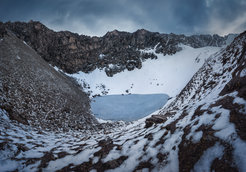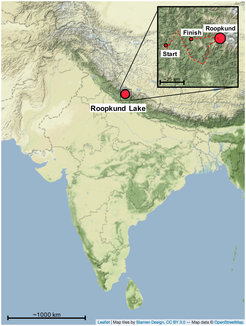Analysis of Roopkund Lake Skeletons Makes Nature Communications’ Top 25
The discovery of Mediterranean migrants among the hundreds of skeletons at the Himalayan lake site highlights the power and importance of interdisciplinary, collaborative research

The skeletons of Roopkund Lake in the Indian Himalayas have fascinated researchers and trekkers alike for generations. The human remains scattered in and around the glacial lake number in the hundreds, and have spawned a wealth of theories about who these individuals were, why they were there, and how they all died.
In August 2019, a study published in Nature Communications applied aDNA analysis, radiocarbon dating, stable isotope analysis and biological anthropology to the mystery, answering some major questions about these individuals and simultaneously raising a few more. Since publication, the study has been accessed more than 99,000 times and been named to Nature Communications’ Top 25 Life and Biological Sciences Articles for 2019.
“Our paper was a major, collaborative effort to combine a range of archaeological science methods to this site, and the results drew attention, at least partly, because of this,” says Ayushi Nayak of the Max Planck Institute for the Science of Human History, co-senior author of the study. “This was the first ancient DNA from South Asia, and while it turns out the remains are not particularly old, the dataset provided completely new information about the site and about migrants during the 19th-20th century, while India was under British colonial control.”

Map showing the location of Roopkund Lake. The approximate route of the Nanda Devi Raj Jat pilgrimage relative to Roopkund Lake is shown in the inset.
The lake was thought to be the site of an ancient catastrophic event that left several hundred people dead, but the first ancient whole genome data from India shows that diverse groups of people died at the lake in multiple events approximately 1000 years apart.
Nayak and her colleagues in India, Europe and the US found that the skeletons at Roopkund Lake represent at least three distinct ancestral groups, with approximately 1000 years separating the deaths of the two largest.
Individuals from the earlier of the two groups, radiocarbon dated to the 7th-10th centuries CE, showed ancestry related to people from present-day India and highly variable diets, suggesting they came from various populations and represent different social classes.
The later group, dated to around 1800 CE, consisted of 14 individuals whose ancestry most closely resembles people from present-day Crete. Why these individuals traveled so far, and what caused their deaths, still remains a mystery.
“This study has shown how critical it is to combine different methods to achieve the fullest possible picture about an archaeological site,” Nayak says. “In an unusual site like Roopkund Lake, the methods that we combined revealed previously unknown, and otherwise unknowable, information about the site. This in itself is crucial, but now our dataset also provides a base on which to consider further research on the site, as well as others like it in the region.”
Read the open-access study here.
And view last year’s press release discussing the findings here.

